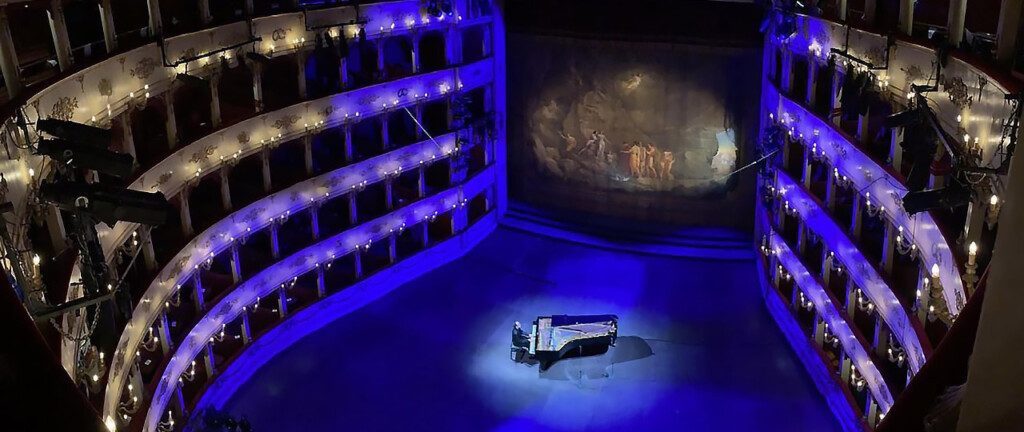A closer look at live streaming: true innovation, or just a flash in the pan?

10.05.21, by Giacomo Luperini
After becoming almost synonymous with live-streaming during the past year and a half, and with the end of the pandemic hopefully in sight, the live music business casts an uncertain look at the future of concert performances.
A single chance event can sometimes have unexpected global consequences, as long-lasting as they are unimaginable. In April 1815, the huge volcano of Tambora in Indonesia played a role in the most significant changes in the art, politics and technology of its time. The Tambora eruption released about 150 billions cubic meters of ash and lapillus – making it the biggest eruption in the history of mankind – and killing more than 60000. The volcanic ash was shot high into the atmosphere, resulting in the so-called “year without a summer”, a dark and cold period during which storms and famine ravaged the planet. It is said that Napoleon lost the battle of Waterloo due to the heavy rain and mud that slowed down his mighty artillery. Famines caused by the dark and cold weather led Europeans to slaughter an increasing number of horses, causing a transport crisis that spurred a young German inventor named Karl Drais into building the first mechanical horse: the draisine, a precursor of our modern bicycles. For the next several years, the volcanic ash turned sunsets a deep red, inspiring Romantic landscapes such as William Turner’s. Finally, it was to escape the cold that Mary Shelley, Lord Byron and John Polidori hunkered down together in a Swiss villa, eventually challenging each other to a literary game that culminated with the writing of “Frankenstein”, “The Vampyre” and “The Burial”, progenitors of the modern horror, gothic and science-fiction literature.
In 2019, an increasing reduction in natural habitats caused a new virus, COVID19, to begin a dangerous process of zoonosis, which quickly allowed it to spark a global pandemic. National governments began to impose restrictions of various kinds, often in relation to live entertainment, which forced concerts and festivals to seek temporary alternatives in order to survive. Live streaming, a sector that up until then had been quite small and aimed at specialized audiences, suddenly began to grow at an unfathomable rate. Soon after, while the world was in turmoil, Dua Lipa shattered all previous concert records by selling more than 284000 tickets and streaming her performance on LIVENow to an audience of more than five million. The live streaming business wasn’t entirely new: in 2010, Bon Jovi live-streamed the first ever worldwide concert on YouTube, which included a previously unknown degree of interaction with the audience (who could suggest and vote songs for the band to perform). Despite frequent collaborations between artists and live-stream platforms over the years, it was the pandemic that truly allowed for the latter’s exponential growth in diversity and number.
Despite an abundance of options, no platform so far has stood out from the mass, or gained a truly official status. STAGELT, for example, offers an almost literal re-creation of a live concert experience: ticket purchases only allow you to view the concert once, with no option to record it or watch it later. However, a “pay what you can” option is also offered, a valuable takeaway from the “sharing economy” model which allows people to choose their ticket price based on their means. Among the most popular platforms we find LIVENow, featuring a wide range of artists and home to the most successful live-streamed concerts of the past few months. LIVENow events can be watched live, or recorded as podcasts for a limited amount of time.
Others, such as LIVEXLIVE, have made their concert experiences customizable based on ticket price. The platform, home to several top names in the business, has created a VIP ticket option that allows for special access to recording sessions or even a virtual chat with the performers.
More interaction means more engagement, which translates to increased audience loyalty. YOUTUBE and TWITCH, the two main players of the live-streaming and podcasting world, know this particularly well. The former has been live-streaming concerts and festivals for years, while the latter, originally created as a gaming platform, has recently been leaning more and more towards music. YouTube has been live-streaming concerts and exclusive content for years, but the pandemic has increased its level of content and subscribers to a matchless degree. It allows users to subscribe to the artists’ own channels, which feature personalized ads and the sale of merchandising, effectively scrapping tickets and rewarding content creators predominantly based on their views. Twitch, once the most popular live-streaming platform for gamers, bases its artists’ fees mainly on channel subscriptions, but allows for even more interaction by offering audiences the opportunity to participate in events such as the creation of shared albums or interactive set lists based on fan requests.
Finally, some artists choose to manage their live-streams themselves, giving fans the option to follow their performances on “Couch Tours” from the comfort of their own home. Patreon, a subscription service, works in a similar way: it lets performers stream their live sets for free on social media, but fans can still choose to offer a financial contribution based on their means.
Nobody yet knows what the post-pandemic music business will look like, just as we don’t know what the world would look like if the Tambora had not erupted. Attending a live performance, watching the light flood the stage while surrounded by the crowd, will always be a romantic, irreplaceable experience; however, the global, customized and interactive aspects of live-streaming have added an unexpected bonus value to live performances, and it is hard to imagine that either audiences or artists will ever choose to give it up.







